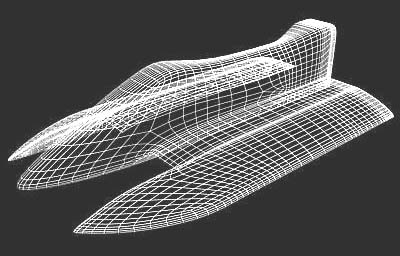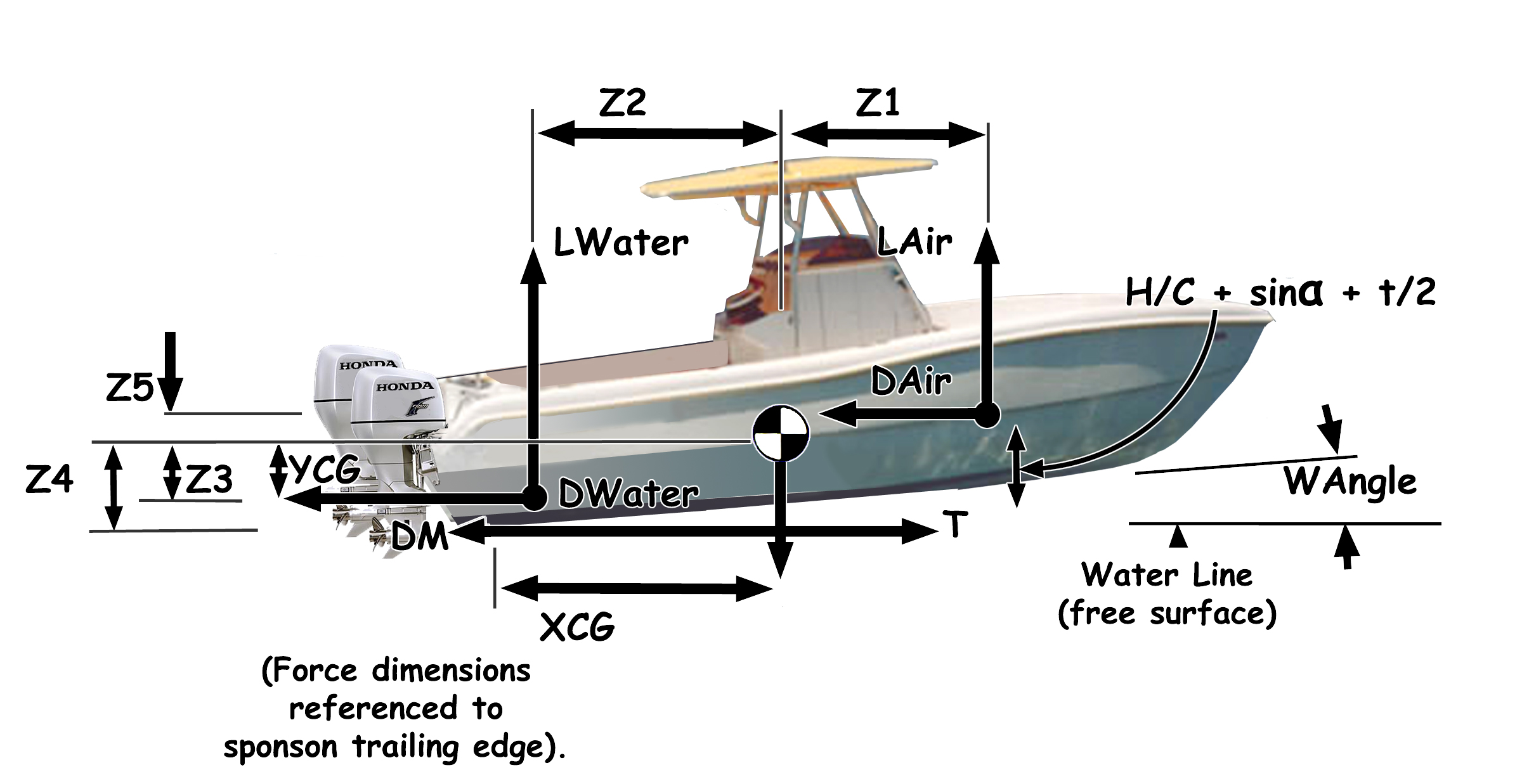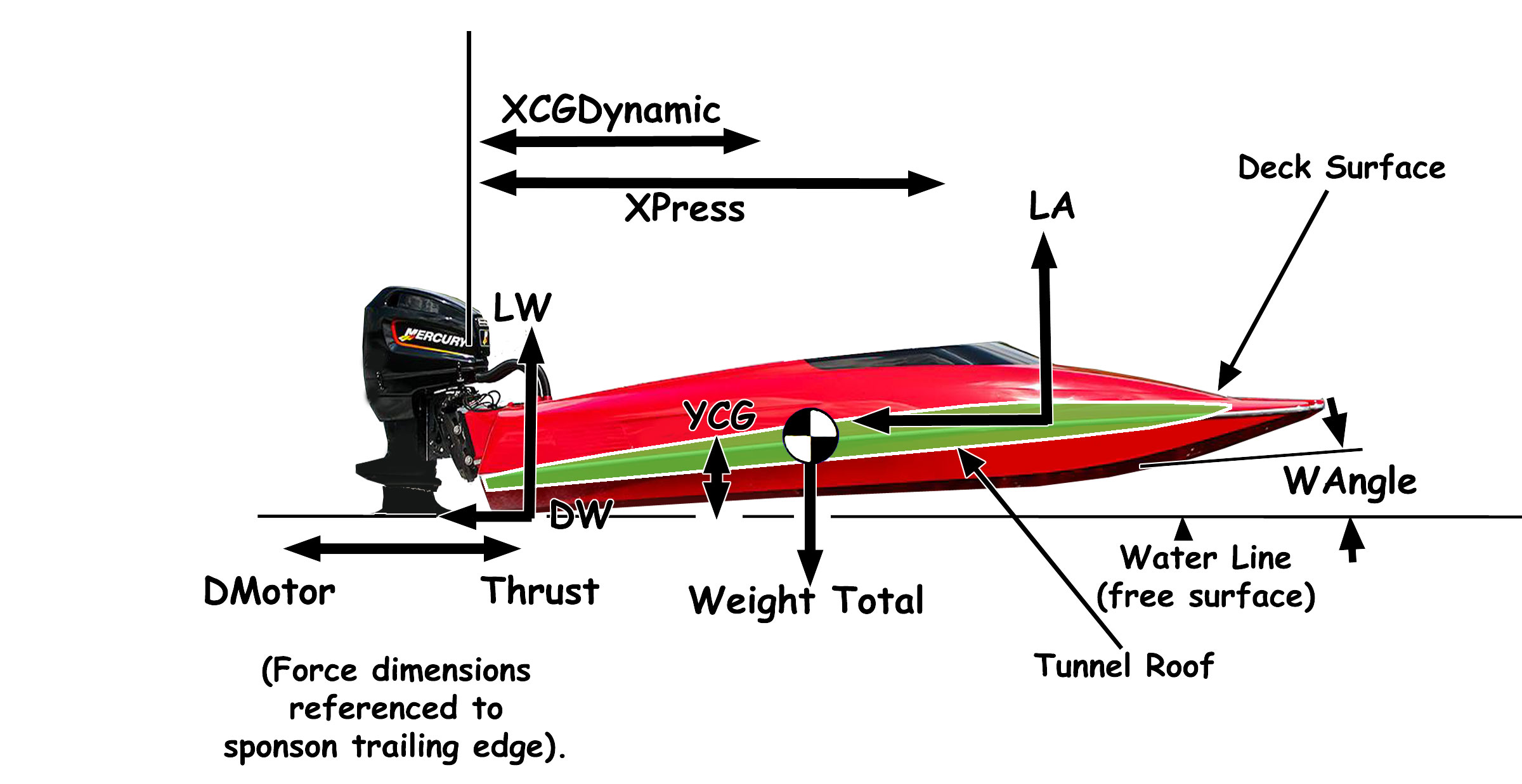
Figure 1 - Underwater test photo, boundary
layer pattern showing stagnation line, pressure area, spray edge [Savitsky, Delorne,
Dalta]

Figure 2 - Wetted
planing surface can be divided into two regions. 1) aft of the
spray-root line, commonly referred to as the pressure area (load
carrying); 2) forward of the spray-root line, referred to as the spray
area (non-lift contributing).

Figure 3 - Complex fluid flow modeling specifically for tunnel and vee
hulls allows accurate computer modeling of these complex designs that
fly in air and on water.


Figure 4 - Forces acting on performance powerboats must include the
influence complex planing surfaces (steps, lifting strakes, centre-pad
surfaces, etc.), and of non-planing forces (aero from low aspect ratio
ground effect hull forms, etc.).

Figure 5 - Effective planing width (bWidth) indicates the progression of
planing phases as velocity and Lift increases. Analysis must
precisely account for bWidth to accurately represent local Lift forces,
Lift center of pressure, friction and spray drag contributions.

Figure 6 - Effective wetted surface length (LWet) is key to
hydrodynamic analysis of all types of Planing surfaces. Research shows
that water builds up forward of hull impingement with free water
surface, affecting effective Length (LWet and Lift center of pressure (CPWet)
|
|
Advanced hydrodynamic analysis
technique gives highly accurate lift and drag contributions to powerboat performance
predictions & optimization.
Hydrodynamic planing research has been advanced by AeroMarine Research®, powerfully
extending Savitsky/Brown, Blount/Fox, Clark and Clement algorithms to
account for the
complexities of mixed lifting forces. AR® has developed
unique algorithms to establish highly accurate hydrodynamic
lift, drag and dynamic stability results that are specific to tunnel hull,
power catamaran, vee hull and vee-pad hulls.
Tunnel hull and catamaran lifting
surfaces are different from conventional hard-chined planing surfaces and cannot simply use traditional planing
algorithms. Performance vee hulls with diminishing planing bWidths,
must have unique algorithms that specifically apply to
distinctive wetted surface shapes and AR. Vee-Pad planing surfaces
are complex, requiring distinctive algorithms to determine performance.
[TBDP©/VBDP© performs for all hull types, all sizes, all powers, all
hull speeds.]
Complex fluid flow
modeling specifically for tunnel and vee hulls allows accurate computer
modeling of these complex designs that fly in air and on water.
Important Considerations
Forces acting on
performance powerboats must include the influence complex planing surfaces
(steps, lifting strakes, centre-pad/pod surfaces, etc.), and of non-planing
forces (aerodynamic contributions from low aspect ratio ground effect hull forms, etc.).
While the normalized derivation for lift from hydrodynamic surfaces
is...
Lw = ˝ • ρW •
V2
•
SW • CLW
where:
Lw = hydrodynamic (water) lift
ρw
= density of water
V = velocity
Sw =
effective wetted surface area
CLW = lift coefficient
The establishment of effective surfaces and related CLW is necessarily
complex.
Hydrodynamic Lift and
drag analysis for performance hulls must consider and accomodate for:
-
Low Aspect Ratio
(AR) planing surfaces (long wetted sponsons) require complex and specific
CLW
algorithm development.
-
Variable deadrise planing surfaces
-
Variable Chine width
-
higher AR planing CLW's (short wetted
area of high performance sponsons and reduced wetted surface vee hulls).
-
effective planing bWidth
-
effective planing Length
-
drag determining pressure area, friction
and
whisker spray drag;
interference drag
-
Lift strakes, spray rails,
trim tabs
-
influence of complex/multiple lateral
steps in planing surfaces
-
center-pod (tunnel hulls) and
vee-pad (vee hulls)
shared lifting surfaces.
All of the above influencing variables are changing constantly with
hull velocity, making the accurate accomodation very complex. What's
more, each of these variables are interdependant (on each other), so the
accurate analysis of CLW,
total Lift and total Drag is tricky.
Also, the complex interdependence of
hydrodynamic Lift/Drag on AR, WAngle, Re/Fr, SWet
is further complicated by the strong inter-dependence of aerodynamic
surfaces Lift/Drag and other appendage drags (cockpit aero drag,
cavity drag,
engine lower unit drag, etc.) - all affecting CLW, SWet, AR of hydrodynamic
lifting surfaces.
[The
analysis methods in 'Secrets
of Tunnel Boat Design' (ISBN# 1-894933-30-3)
and AeroMarine Research
TBDP©/VBDP©
software demonstrate the development of proven algorithms that solve all of
these challenges accurately.]
When one of these influencing
forces change, the hydrodynamic lift/drag, SWet and WAngle (trim angle)
and dynamic stability are systematically affected.
The analysis to balance these inter-dependent forces throughout velocity
range is complex, and is key to accurate performance prediction.
The AeroMarine Research TBDP©/VBDP©
software doesn't use any 'C' constants, 'shape coefficients' or 'speed factors' to simulate different
hull types, shapes or velocity/size ranges. - it analyzes all design and dimensional aspects of each hull
from first engineering principles, proven by research and full-scale
testing. [This is a unique feature of TBDP©/VBDP©, as most all
other performance analysis software products rely on choosing
'fudge-factors' to adjust results to expected hull types! TBDP©/VBDP©
software gets the right answer based on pure hull design.
NO FUDGE FACTORS REQUIRED!]
TBDP©/VBDP© software uses Finite
Element analysis techniques to accurately calculate the many affecting
hydrodynamic factors that are constantly changing and highly influence
each other. The power of these techniques and the software allows for
comprehensive analysis, employing engineering techniques that include the
critical inter-dependence of aerodynamic, hydrodynamic and stability
calculation methods that are key to proper Tunnel hull design and accurate
performance prediction.
Russell's development of Advanced Hydrodynamic techniques
included direct liaison with Prof. David Savitsky re: planing
characteristics, and were
ultimately verified through wind tunnel testing, water channel testing and full
scale hull verification testing.
Effective planing width (bWidth) indicates the progression of planing
phases as velocity and Lift increases. Analysis must precisely account
for bWidth to accurately represent local Lift forces, Lift center of
pressure, friction and spray drag contributions. Effective bWidth and
wetted length of each planing surface have significant impacts on Lift and
drag forces and locations for dynamic stability moments.
How it
Works
The total
wetted bottom area of a planing surface can be divided into two regions. One
is aft of the spray-root line, commonly referred to as the pressure area,
and the other is forward of the spray-root line, referred to as the spray
area. The pressure area is the load-carrying area of the planing bottom,
generating hydrodynamic Lift (and drag).
The spray area contributes drag but is not considered to support any
portion of the load.
The forward portion of this
lifting area is a triangular shape (simply due to the geometry of the veed
hull). Behind this triangle, defined by the "stagnation line" is the lifting
area – this is the wetted surface that does the good work of lifting the
hull out of the water. Ahead of the stagnation line, there is an area that
experiences "whisker spray" from the high velocity water that flows along the hull surface.
The "whisker" spray from highly loaded lifting surfaces can wet a
significant portion of your hull surface, causing additional drag without
the benefit of any lift.
When a performance hull is planing, particularly at higher speeds, the hull gets it's lift from
aerodynamic surfaces and the wetted lifting area of the hull bottom. To
the extent the 'aero' lift contributions are significant, the hydrodynamic
lift requirements (and associated drags) are reduced. Because the cost (in
HP) of water-drag can be 800 times more than that of aero-drag, the
benefit in wetted surface (and drag) reduction can result in appreciable
gains in performance.
Accurate computation of hydrodynamic lift
and drag contributions rely on similarly precise analysis of the strong
interdependence with contribution aerodynamic surfaces Lift/Drag and other
appendage drags including cockpit aero drag, cavity drag, engine lower
unit drag, etc. - as all of these dependencies affect the CLW, SWet, AR of
hydrodynamic lifting surfaces and resulting dynamic stability.
The
performance effects of friction drag,
profile drag, induced drag, sheer spray drag and whisker spray drag generated by all Vee
hull, Vee-pad hull, tunnel hull and modified-tunnel hull types of powerboat applications is developed by Russell. The results are accurate representation of
hydrodynamic drag associated with all performance powerboat configurations, using Russell's analysis techniques in the "Tunnel Boat Design Program" and "Vee Boat Design
Program" software.
Russell applies these advancements in
newest versions of AR's TBDP©/VBDP© performance
analysis software. |







